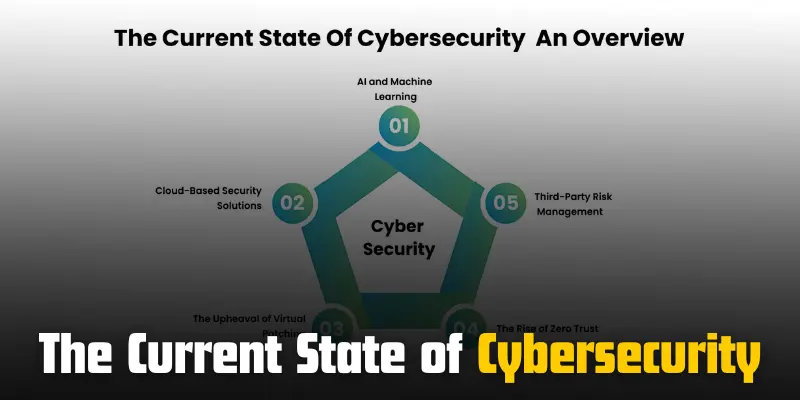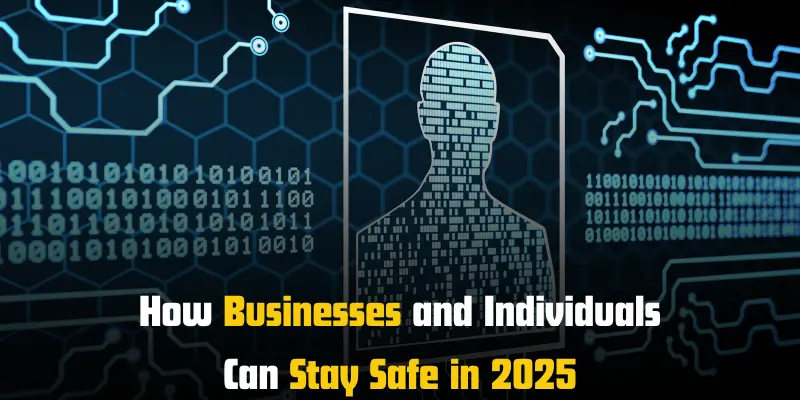Protecting Your Data: Key Cybersecurity Trends in 2025
Published: 21 Mar 2025
Picture this: It’s 2025, and your personal data is as valuable as gold. Hackers are getting smarter, and cyber threats are growing more complex. From the rise of artificial intelligence to the spread of Internet of Things (IoT) devices, the cybersecurity landscape is changing rapidly. But how do we stay ahead of these new dangers? In this post, we’ll dive into what you need to know about cybersecurity in 2025 and how you can protect yourself from the dangers lurking in the digital world.
Introduction
As we continue to live more of our lives online, the need for strong cybersecurity has never been greater. In 2025, the digital world will be more connected than ever before, with everything from smartphones to smart homes relying on the internet to function. This rapid expansion brings new challenges for protecting our personal information, financial data, and even our privacy.
Cyber threats are becoming more sophisticated and widespread, making cybersecurity a critical part of our everyday lives. In a world where we are online more than ever, protecting our data is crucial—not just for businesses, but for individuals too. Without proper security measures in place, we risk exposing sensitive information to hackers and malicious actors.
The Current State of Cybersecurity

Cybersecurity today is largely based on traditional defense mechanisms, but as technology advances, new and more sophisticated threats emerge. Let’s take a closer look at how cybersecurity is managed in the present day and the common cyber threats businesses and individuals face.
Cybersecurity Today
Cybersecurity methods today are designed to protect sensitive data from attacks, but with the growing complexity of cyber threats, these tools need to be more adaptive.
- Firewalls
Firewalls are used by businesses and individuals to filter out unauthorized traffic from reaching a network. They act as a barrier between trusted internal systems and external threats. - Antivirus Software
Antivirus programs are designed to detect and remove harmful software like viruses, worms, and malware. Many devices use antivirus software to block known threats. - Encryption
Encryption helps protect sensitive data by converting it into unreadable text that can only be unlocked with a decryption key. This ensures that even if data is intercepted, it cannot be read.
Example: “Right now, many businesses use firewalls to block cyber threats, but as cyber attacks get smarter, these methods need to evolve.”
Common Cyber Threats
Cyber threats are becoming more sophisticated, and understanding the most common types of attacks can help businesses and individuals stay safe.
- Hackers
Hackers are individuals or groups who try to gain unauthorized access to systems to steal information or cause damage. They can use various techniques, including exploiting vulnerabilities in software. - Phishing Attacks
Phishing is when cybercriminals trick people into giving away personal information, like passwords or credit card numbers, by posing as legitimate companies or people in emails or messages. - Ransomware
Ransomware is a type of malicious software that locks or encrypts a victim’s files, holding them hostage until a ransom is paid. Hospitals, schools, and businesses are often targeted, and data is often lost or stolen.
Example: “In 2023, ransomware attacks targeted hospitals, locking critical medical data until a ransom was paid.”
Emerging Cybersecurity Trends in 2025
As the digital world continues to evolve, so do the methods of cyberattacks. To stay ahead, cybersecurity is adapting and using advanced technologies to protect data and networks. Let’s explore the emerging trends in cybersecurity for 2025.
Artificial Intelligence in Cybersecurity
AI is revolutionizing the way cybersecurity is handled by automating threat detection and response.
- Predicting Attacks
AI systems can analyze vast amounts of data to predict where and when cyberattacks might occur. This helps prevent breaches before they happen. - Automated Threat Detection
AI can spot unusual patterns in online activity, quickly identifying potential threats that humans might miss. - Speeding Up Responses
AI can respond to threats in real time, blocking cyberattacks instantly before they can cause any damage.
Example: “AI systems can now detect patterns in online activity and spot potential threats before they happen.”
Zero Trust Security Models
The Zero Trust model operates on the principle that no one, inside or outside the network, should be trusted by default.
- No Trust, Only Verification
Every user and device, even within the network, must prove its identity every time it attempts to access resources. - Limited Access
Access to data or systems is restricted based on the user’s role, ensuring that only the necessary information is available to them. - Continuous Monitoring
Zero Trust continuously monitors users and devices for signs of suspicious behavior, ensuring a proactive defense against breaches.
Example: “Imagine a business where every employee has to prove their identity every time they log in—this is Zero Trust.”
Cloud Security Advancements
With more data being stored on the cloud, protecting it has become even more critical.
- Growing Importance of Cloud Storage
Many businesses now rely on the cloud to store and manage their data, making cloud security a top priority. - Securing Cloud Networks
Cybersecurity measures are advancing to protect cloud systems, ensuring data is encrypted and access is controlled. - Shared Responsibility Models
Cloud providers and users share the responsibility for securing data, with the provider securing infrastructure and the user ensuring data safety.
Example: “More companies store their data in the cloud now, which means protecting it from hackers is more important than ever.”
5G and Cybersecurity
The rollout of 5G networks is transforming connectivity, but it also introduces new cybersecurity challenges.
- Faster, More Connected Devices
5G allows more devices to connect to networks at higher speeds, increasing the number of entry points for cybercriminals. - More Targeted Attacks
As more devices and networks are connected, 5G networks can be targeted by attacks like Distributed Denial of Service (DDoS), which can overload a network with traffic. - Need for Advanced Security Solutions
To handle the new risks associated with 5G, cybersecurity systems must evolve to defend against more complex attacks.
Example: “With faster internet speeds, more devices can connect to networks, and this creates more entry points for hackers.”
New Types of Cyber Threats in 2025
As technology continues to advance, cybercriminals are finding new and more sophisticated ways to attack. Here are some of the emerging threats that are becoming more common in 2025.
Sophisticated Phishing and Social Engineering
Phishing attacks are becoming more advanced, making it harder for people to recognize and avoid them.
- More Realistic Fake Websites
Cybercriminals are now able to create fake websites that look exactly like the real ones, making it difficult for users to tell the difference. - Advanced Email Scams
Phishing emails are becoming more personalized, often using data from social media to make them seem more legitimate. - Manipulating Trust
Social engineering attacks now focus on manipulating human emotions, like fear or urgency, to convince people to give up personal information.
Example: “Cybercriminals can now create fake websites that look just like your bank’s page, tricking users into giving away sensitive information.”
Internet of Things (IoT) Vulnerabilities
With the rise of connected devices, new vulnerabilities are appearing in the Internet of Things (IoT), putting both individuals and businesses at risk.
- More Devices, More Risk
As more devices like smart fridges, watches, and thermostats connect to the internet, they become targets for hackers. - Insecure Devices
Many IoT devices don’t have strong security features, making it easier for attackers to hack into them and gain control over personal data or even the devices themselves. - Hijacking Household Devices
A hacker could take control of your smart devices, turning them into tools for spying or launching other attacks.
Example: “Imagine your smart fridge being hacked—it could be a scary scenario if attackers gain control over household devices.”
How Businesses and Individuals Can Stay Safe in 2025

In 2025, both businesses and individuals need to be proactive in protecting themselves from cyber threats. Here are some key steps to stay safe.
For Businesses: Strengthening Your Cyber Defenses
Businesses face greater risks of cyberattacks, and protecting sensitive data should be a top priority. Here are some ways businesses can strengthen their cybersecurity:
- Use Multi-Factor Authentication (MFA)
MFA adds an extra layer of security beyond just passwords, requiring users to provide additional verification like a code sent to their phone. - Regular Software Updates
Keeping software up to date ensures that security vulnerabilities are patched and minimizes the risk of attacks exploiting outdated systems. - Employee Training and Awareness
Regularly training employees to recognize common cyber threats, like phishing scams, ensures they don’t fall victim to attacks that could compromise the entire business.
Example: “Setting up MFA requires more than just a password, making it harder for hackers to break in.”
For Individuals: Simple Steps to Protect Yourself
Individuals also need to take responsibility for their own cybersecurity. Here are a few easy steps to protect personal data online:
- Use Strong, Unique Passwords
Create strong passwords that are difficult for hackers to guess and avoid using the same password across multiple sites. - Avoid Suspicious Links and Emails
Be cautious when clicking on links in emails or text messages. Phishing scams often appear as legitimate messages, tricking users into giving away personal information. - Use a Virtual Private Network (VPN)
VPNs encrypt your internet connection, making it harder for hackers to intercept your data, especially when using public Wi-Fi.
Example: “Using a password manager can help you keep track of all your passwords without reusing the same one.”
The Future of Cybersecurity in 2025 and Beyond
As technology continues to advance, the future of cybersecurity is evolving rapidly. Two key areas that will shape cybersecurity in 2025 and beyond are privacy regulations and the growing demand for cybersecurity professionals. Let’s take a look at these important trends.
The Role of Privacy Regulations
With the increasing amount of personal data shared online, privacy regulations are becoming a crucial part of cybersecurity. These laws help protect individual data and ensure that companies handle it responsibly.
- Introduction to GDPR and Other Privacy Laws
The General Data Protection Regulation (GDPR) is a law in the European Union that requires companies to protect the personal data and privacy of EU citizens. Other countries are implementing similar regulations to protect their citizens’ data. - User Consent for Data Collection
Under GDPR and similar laws, companies must get your explicit consent before tracking your online behavior or collecting personal information. This ensures that users have more control over their data. - Increased Accountability for Businesses
Companies are now held accountable for how they collect, store, and protect customer data. If a business fails to comply with these regulations, it could face heavy fines and damage to its reputation.
Example: “Companies must now get your consent before tracking your online behavior, protecting your personal data.”
The Growing Need for Cybersecurity Professionals
As cyber threats become more complex, businesses are facing an increased demand for skilled cybersecurity professionals to safeguard their networks, systems, and data.
- Expanding Cybersecurity Job Market
The field of cybersecurity is growing rapidly, with businesses needing more experts to handle the challenges of securing digital assets against evolving threats. - Specialized Roles and Skills
As cyber threats become more advanced, cybersecurity professionals with specialized skills, such as threat analysis, incident response, and ethical hacking, will be in high demand. - Opportunities Across Industries
Cybersecurity experts are needed in all sectors, including healthcare, finance, and government, where protecting sensitive data is crucial to maintaining trust and security.
Example: “In 2025, businesses will need more skilled professionals to handle complex cybersecurity issues.”
Conclusion
So guys, in this article, we’ve covered Cybersecurity in 2025 in detail. The future of cybersecurity is rapidly changing, and it’s essential to adapt to these new challenges. I recommend businesses start implementing Zero Trust security models and that individuals make use of strong passwords and VPNs for everyday protection. It’s time to get ahead of the curve—secure your digital life and take action before it’s too late. Stay safe online!
Frequently Asked Questions (FAQs)
Cybersecurity is the practice of protecting your computer systems, networks, and data from cyberattacks. It’s important because more of our personal and business information is online, making it vulnerable to theft or misuse. Without cybersecurity, our personal data and privacy could be at risk.
Businesses should implement multi-factor authentication (MFA) to add an extra layer of security. They should also ensure regular software updates and train employees on recognizing cyber threats like phishing. These simple steps can help protect sensitive data from cybercriminals.
Multi-factor authentication (MFA) is a security process that requires users to verify their identity in two or more ways, like entering a password and receiving a code on their phone. It adds extra protection by making it harder for hackers to access accounts. MFA is one of the best ways to secure online accounts.
Phishing attacks are attempts to steal personal information by pretending to be a trusted entity, often via email or fake websites. To avoid them, be cautious of unexpected emails, never click on suspicious links, and always verify website URLs. Protecting your personal info from phishing is key to avoiding data theft.
AI helps by analyzing patterns in online activity and spotting potential threats before they happen. It can detect unusual behavior in real-time and block attacks immediately. This makes it easier to protect against cybercriminals who are becoming more sophisticated.
Zero Trust is a security model where no one, even those within the network, is trusted by default. Every user and device must be verified before accessing any company data. This approach reduces the risk of internal and external threats.
Encryption converts sensitive data into unreadable text that only authorized parties can decrypt. This protects your personal information, like credit card numbers, from being accessed by hackers. Using encryption is a vital part of keeping data safe, especially when it’s being transmitted over the internet.
To protect yourself online, use strong passwords, avoid clicking on suspicious links, and use a Virtual Private Network (VPN) when using public Wi-Fi. These steps can help safeguard your personal information and reduce the risk of cyberattacks. Staying aware of potential threats is also crucial.

- Be Respectful
- Stay Relevant
- Stay Positive
- True Feedback
- Encourage Discussion
- Avoid Spamming
- No Fake News
- Don't Copy-Paste
- No Personal Attacks

- Be Respectful
- Stay Relevant
- Stay Positive
- True Feedback
- Encourage Discussion
- Avoid Spamming
- No Fake News
- Don't Copy-Paste
- No Personal Attacks



